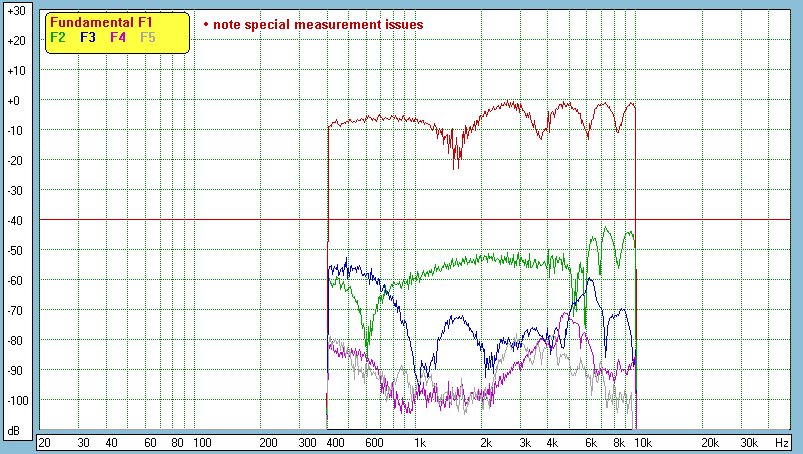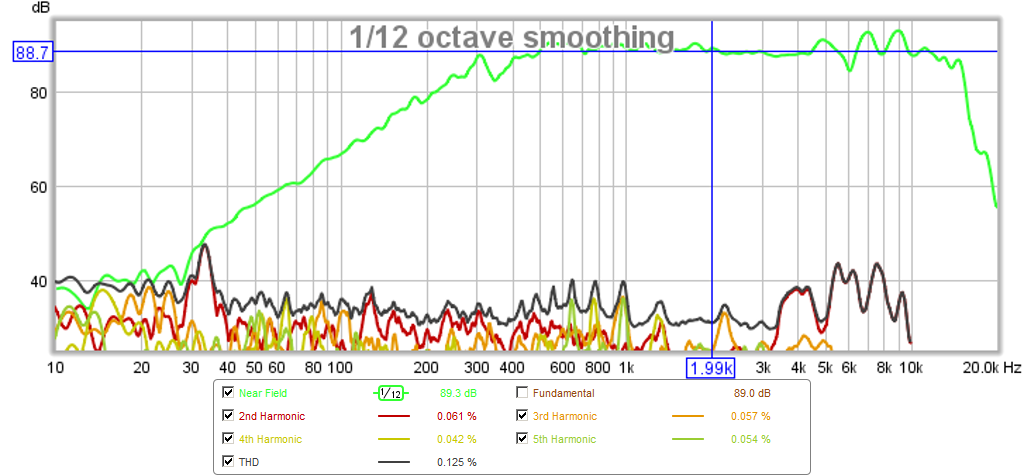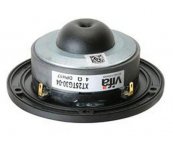I've noticed that is is very little difference in sound between good tweeters.
I think the Vifa XT25 is cleaner than the Seas and a Wavecor tweeter I have, but I don't know if it's psychological because I've seen the almighty Zaph's distortion measurements or if I'm hearing something.
The Wavecor TW030WA07 (no ferrofluid, but 8 ohm) tweeter is by far the most sensitive then the Vifa (single magnet, 4 ohm) and then the Seas (6 ohm). I was surprised the seas was last.
Seems like low distortion drivers are very close in sound, especially tweeters.
The tweeters vary in sensitivity quite a bit, but not sound quality.
I think the Vifa XT25 is cleaner than the Seas and a Wavecor tweeter I have, but I don't know if it's psychological because I've seen the almighty Zaph's distortion measurements or if I'm hearing something.
The Wavecor TW030WA07 (no ferrofluid, but 8 ohm) tweeter is by far the most sensitive then the Vifa (single magnet, 4 ohm) and then the Seas (6 ohm). I was surprised the seas was last.
Seems like low distortion drivers are very close in sound, especially tweeters.
The tweeters vary in sensitivity quite a bit, but not sound quality.
What is sound quality?
It's absence of "driver" character (distortion).
So of course two soft-material drivers with the same polar pattern in the midrange are going to sound more similar than not in the frequencies where most audio resides. Especially if they measure the same WRT frequency response. Even moreso if you're crossing them so high that neither is undergoing any strain on its bottom-end.
Doesn't mean all good drivers sound the same but it does mean that system design trumps "driver character", although system design often dictates driver character anyways. Now personally, I have found that compared to soft domes, aluminum domes like the Seas TBFC are a little bit cleaner throughout the range than soft ones like the TDFC. And since pretty engineering-driven companies like KEF, Revel, Genelec seem to like them too, I'm not embarassed by the "audiophile stigma" that metal domes are harsh.
It's absence of "driver" character (distortion).
So of course two soft-material drivers with the same polar pattern in the midrange are going to sound more similar than not in the frequencies where most audio resides. Especially if they measure the same WRT frequency response. Even moreso if you're crossing them so high that neither is undergoing any strain on its bottom-end.
Doesn't mean all good drivers sound the same but it does mean that system design trumps "driver character", although system design often dictates driver character anyways. Now personally, I have found that compared to soft domes, aluminum domes like the Seas TBFC are a little bit cleaner throughout the range than soft ones like the TDFC. And since pretty engineering-driven companies like KEF, Revel, Genelec seem to like them too, I'm not embarassed by the "audiophile stigma" that metal domes are harsh.
Last edited:
The XT25 is a ring radiator.
It has very little non-linear distortion above 2 KHz, that's why I was surprise the seas and Vifa sounded very similar. Or rather I can't tell the difference between the two or I'm not sure. I would use the Seas instead, if in fact it's possible I can't hear the difference.
I think the Vifa is cleaner with the 8.2 uF caps, but I'm no sure because I have already seen the graphs. Vifa graph is way cleaner above 3 KHz, but can any one actually hear the difference? Does any one even know the answer to these questions or do people just try to build with the lowest distortion they can find?
Basically, my question is: Is the distortion in the Seas audible above 3 KHz or where that capacitance crosses the tweeters over?
3.2 KHz for Seas and 4.8 KHz for Vifa at 6 and 4 ohms respectively.
It has very little non-linear distortion above 2 KHz, that's why I was surprise the seas and Vifa sounded very similar. Or rather I can't tell the difference between the two or I'm not sure. I would use the Seas instead, if in fact it's possible I can't hear the difference.
I think the Vifa is cleaner with the 8.2 uF caps, but I'm no sure because I have already seen the graphs. Vifa graph is way cleaner above 3 KHz, but can any one actually hear the difference? Does any one even know the answer to these questions or do people just try to build with the lowest distortion they can find?
Basically, my question is: Is the distortion in the Seas audible above 3 KHz or where that capacitance crosses the tweeters over?
3.2 KHz for Seas and 4.8 KHz for Vifa at 6 and 4 ohms respectively.
To me they sound very,very different!The seas is more sibilant and sharp.
I like the vifa better.
I like the vifa better.
Hi,
All good 1" domes used properly will sound similar,
far more so than different, differences are subtle.
The Seas has superb lower frequency distortion :

The Vifa, is worse lower, but better higher :

The Seas without the Vifa impedance peak, and earlier roll-off
is easier to massage into a nice acoustic roll-off with less
components than the Vifa, typically.
rgds, sreten.
All good 1" domes used properly will sound similar,
far more so than different, differences are subtle.
The Seas has superb lower frequency distortion :

The Vifa, is worse lower, but better higher :

The Seas without the Vifa impedance peak, and earlier roll-off
is easier to massage into a nice acoustic roll-off with less
components than the Vifa, typically.
rgds, sreten.
Last edited:
I know that this driver is not a tweeter but it has very nice coverage from 300 Hz to about 15kHz which is fine for me. Yes, there are cone breakup modes up there but if you look at the HD, it is incredibly low. And when you listen to vocals with it, you can hear a difference with others relatively low HD drivers. There is an audible difference between -40dB and -50dB HD drivers. The voices and notes simply sound cleaner and more clear.

This is the PRV 5MR450NDY - it can reach some pretty high SPL levels too with a 225w rms rating.

This is the PRV 5MR450NDY - it can reach some pretty high SPL levels too with a 225w rms rating.
To me they sound very,very different!The seas is more sibilant and sharp.
I like the vifa better.
Okay, yes this is what I was hearing.
I was hoping it goes away, apparently it doesn't.
I also noticed the Seas has better off-axis response, but I did not see a "phase plate" on the grill. I have the TDFC/G, it's the soft dome version of the TBFC/G.
I would use the Vifa, but the Seas comes with a metal grill on it, so I'm tempted to use it.
I don't think I will be making a passive speaker, but I'm not sure.
I've seen the distortion graphs and I think it's more important for a tweeter to have a clean low end.
A rather large reduction in low end distortion is afforded to the xt25 when combined with a pellegrine acoustics waveguide.
I can't speak for the TDFC/G, since I don't have it, but the TBFC/G has an acoustic lens. It is a small round piece of transparent plastic glued internally onto the grill.I also noticed the Seas has better off-axis response, but I did not see a "phase plate" on the grill. I have the TDFC/G, it's the soft dome version of the TBFC/G.
Ralf
I guess the reason seas makes a sharper sound is because of that 3rd harmonic peak in just the area most sensitive to such things.
XT25 (especially double magnet version) is a great tweeter if it wasn't for a challenge of crossing it low. In a waveguide it can work miracles. And you will likely need that LCR on it's Fs in any case.
IMHO - distortion is audible in lesser quantities in amps, compared to it tweeters and drivers are distortion monsters
XT25 (especially double magnet version) is a great tweeter if it wasn't for a challenge of crossing it low. In a waveguide it can work miracles. And you will likely need that LCR on it's Fs in any case.
IMHO - distortion is audible in lesser quantities in amps, compared to it tweeters and drivers are distortion monsters
Last edited:
I find the Vifa to sound darker, even if it plays louder than the mid unit it still sounds different to my ears but if used properly is a very nice tweeter. Shaping its response to a 2nd order 2.5Khz LR ideal down to about 700Hz is easily achieved with a single cap but requires an optional component many designers miss - an LCR circuit for the impedance peak at around 550Hz depending on the tweeter production batch. Its presense in the top octaves is a bit weak for my taste too.
Here's the thing that most people miss about the XT25 - it's got a hole in the back of the magnet to help it breathe.
So if you've got it in the same chamber as a mid or a mid/woofer, sound and air pressure can go in just as easily as they go out.
I put mine in its own little chamber to isolate it.
So if you've got it in the same chamber as a mid or a mid/woofer, sound and air pressure can go in just as easily as they go out.
I put mine in its own little chamber to isolate it.
No, there's no hole there - it just looks like a hole. If you haven't disassembled XT25 and seen plastic cover from the inside- you can just blow air into the hole and make sure it's sealed...At least mine are
Last edited:
This should help - in this video XT25 being disassembled:Well, that's interesting. I certainly thought it looked like a vent like in the picture below.
I don't think I'm going to remove them from my speakers to check - I wonder if anyone else can confirm that?
https://www.youtube.com/watch?v=U4e6E3Rog84
At the end check the inner shape of plastic cap - it has sharp pike in center and that's why there's a hole on opposite side i think..
Thanks for that.
That tweeter is slightly different than the one I have but it does look as if the hole in the back does not go all the way through. I certainly thought it was for the purposes of venting but it looks as though I may have been wrong.
Good to know.
That tweeter is slightly different than the one I have but it does look as if the hole in the back does not go all the way through. I certainly thought it was for the purposes of venting but it looks as though I may have been wrong.
Good to know.
I know that this driver is not a tweeter but it has very nice coverage from 300 Hz to about 15kHz which is fine for me. Yes, there are cone breakup modes up there but if you look at the HD, it is incredibly low. ...
This is the PRV 5MR450NDY - it can reach some pretty high SPL levels too with a 225w rms rating.
You are using way too low spl level to see distortion. Seas/Vifa have H2 at -60dB level. Your measurement is just showing room noise!
I find the Vifa to sound darker, even if it plays louder than the mid unit it still sounds different to my ears but if used properly is a very nice tweeter. Shaping its response to a 2nd order 2.5Khz LR ideal down to about 700Hz is easily achieved with a single cap but requires an optional component many designers miss - an LCR circuit for the impedance peak at around 550Hz depending on the tweeter production batch. Its presense in the top octaves is a bit weak for my taste too.
Thank you for this review.
This exactly what I want in a tweeter.
I will use the Vifa, even though it doesn't have a grill.
I guess I will have to make one.
I also liked the youtube video. Seems well designed internally.
Btw, scanspeak version of XT25 while seem identical - sounds (slightly) better, although Vifa's make tend to have 1db more sensitivity. And in any case i'd recommend double magnet version.
Also something one can't see from generic measurements - i noticed the lower you push XT25 in crossover frequency, the less detailed it sounds when you increase volume so it's clear the Xmax is the main limitation so that's why people like to use it with waveguides or cross high or with high order...
Was my favorite tweeter until i moved to larger domes (1.3-1.5") 🙂
Also something one can't see from generic measurements - i noticed the lower you push XT25 in crossover frequency, the less detailed it sounds when you increase volume so it's clear the Xmax is the main limitation so that's why people like to use it with waveguides or cross high or with high order...
Was my favorite tweeter until i moved to larger domes (1.3-1.5") 🙂
Btw, scanspeak version of XT25 while seem identical - sounds (slightly) better, although Vifa's make tend to have 1db more sensitivity. And in any case i'd recommend double magnet version.
Also something one can't see from generic measurements - i noticed the lower you push XT25 in crossover frequency, the less detailed it sounds when you increase volume so it's clear the Xmax is the main limitation so that's why people like to use it with waveguides or cross high or with high order...
Was my favorite tweeter until i moved to larger domes (1.3-1.5") 🙂
I do like the Wavecor tweeter (30 mm) I have the best, but I'm only using a 95 cm^2 woofer.
I don't know what to do again 😕
- Status
- Not open for further replies.
- Home
- Loudspeakers
- Multi-Way
- How come there's no difference in sound between Seas 27TDFC/G and Vifa XT25
